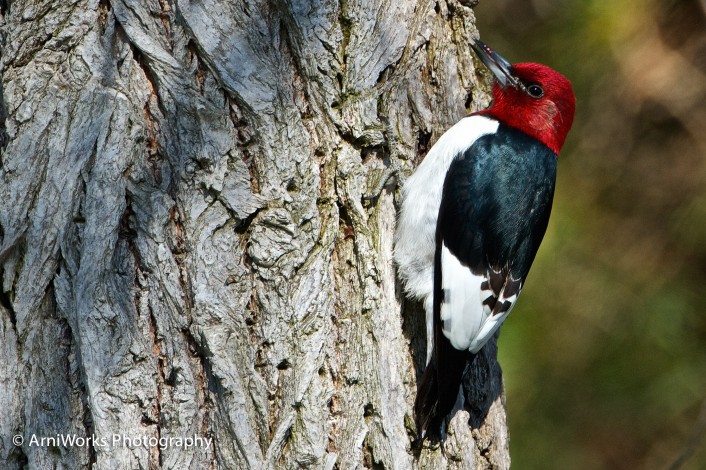We have all said it at one time or another, “I wouldn’t go across the street to see…!” True for me, as there are some birds that are just so common I wouldn’t cross the street to see one, a Blue Jay for instance. However, there are others I would drive miles to see, such as a Gray Jay. I recently read of a man who lives just outside of London, England. He was in the Hebrides searching for a particular species of gull, when he had a phone call telling him there was a South American migrant bird he had never been found in California. Within a matter of hours he had flown to southern California to locate this bird. He found it and returned immediately to the U.K.
Well, I am not one of those who would travel half-way around the world to see a single bird. However, when a rare bird is located nearby I have been known to search it out. This happened last week. I had an e-mail note from a friend who said that she had a Red-headed woodpecker in her yard and that it had been there for about a week.
The Red- headed woodpecker is a striking bird with a bright red head, contrasting blue/ black back and primary wing feathers and white breast and secondary wing feathers. It exhibits similar behavioural characteristics of all woodpeckers such as flight and tree climbing pattern. It is that solid bright red head that makes it easy to distinguish it from other members of the woodpecker family.
I have only ever seen two Red- headed woodpeckers. One was just a fleeting glance as a bird travelled through our yard, and another as it chased a Pileated woodpecker down our road just over the tree tops.
We tend to be at this woodpecker’s most northern boundary, and therefore it is rather rare in our area. South and south western Ontario have the greatest abundance of this species in Ontario. Some birds will stay year round in those areas, but most birds will migrate into the United States for the winter. Of utmost importance for them is the presence of habitat which includes large, dead trees or live trees with large dead branches. They do well on golf courses and open woodlands.
When they return in mid May, they will form pairs, and excavate a nest cavity prior to the female laying 5-6 eggs. Red-headed woodpeckers eat mainly insects, catching them with their long, sticky and barbed tongue which can extend 3-4 inches out of their mouth.
I was tied up the latter part of the week, but told my friend I would be there early on Saturday morning. I hardly slept Friday night. I had visions of a gorgeous Red-headed woodpecker in my camera viewfinder. On arrival I wasted little time getting camera and gear out the back of the car, and off I went to where I thought I would get the best light and background. The area was inundated with Blue Jays, Chickadees, Nuthatches and Finches. I waited and waited, an hour passed, but no Red- headed woodpecker. Skunked again….not the first time, and it won’t be the last! Having a disappointment like this is not new to birders.
I fretted all the way home. Opening my e-mail, my spirits were lifted by a note from my photographer friend Arni Stinnissen. He had just heard from a mutual friend who had an extremely rare bird in their yard. He was asking if I’d like to go with him to check out this rare find?
That’s another story I’ll share with you next time! In the meantime, Christmas Blessings from our house to yours!
Written by David A. Homer. President of the Board of Directors.

